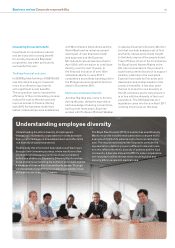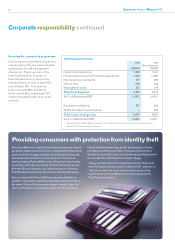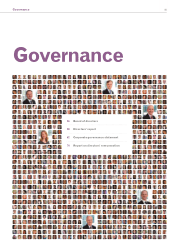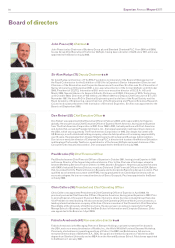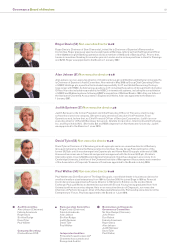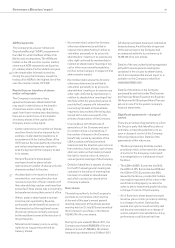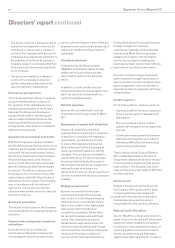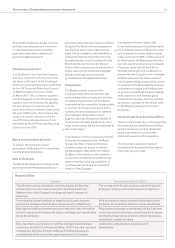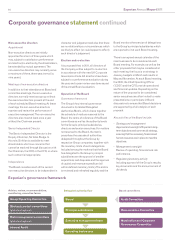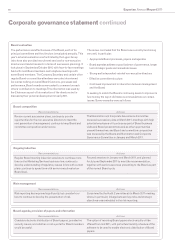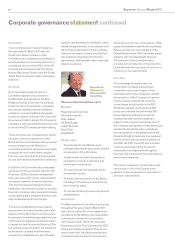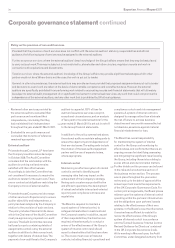Experian 2011 Annual Report Download - page 65
Download and view the complete annual report
Please find page 65 of the 2011 Experian annual report below. You can navigate through the pages in the report by either clicking on the pages listed below, or by using the keyword search tool below to find specific information within the annual report.
Governance Corporate governance statement 63
Shareholder feedback is always welcome
and if you have any particular comments
or observations about this corporate
governance statement, please email
governance@experian.com.
Compliance statement
It is the Board’s view that the Company
has been compliant with the provisions
set down in Section 1 of the Combined
Code on Corporate Governance published
by the UK Financial Reporting Council
in 2008 throughout the year ended
31 March 2011. This statement, together
with the diagram on the following page,
explains how the Company has applied
the principles and complied with the
provisions of the Combined Code during
the year. Additionally, the Company has
chosen to comply voluntarily with the
new UK Corporate Governance Code
published by the UK Financial Reporting
Council in June 2010.
Board and committee structure
To support the principles of good
governance, the Board and its committees
operate as described below.
Role of the Board
The Board sets Experian’s strategic goals
and ensures that the necessary financial
and human resources are in place to achieve
the goals. The Board reviews management
and financial performance against those
goals. It is accountable to shareholders for
delivering financial performance and long
term shareholder value. To achieve this, the
Board directs and monitors the Group’s
affairs within a framework of controls which
enable risk to be appraised and managed
effectively through clear and robust
procedures and delegated authorities.
Composition
The Board currently comprises the
Chairman, three executive directors and
seven independent non-executive directors
including a Deputy Chairman. The Board
considers that its composition is appropriate
to oversee the Group’s businesses and is
suitably diverse in background to address
the challenges of the areas in which
Experian operates. Biographical details of
the directors, including details of any other
major directorships, are set out elsewhere in
this annual report.
In accordance with the provisions of the UK
Corporate Governance Code, the Board
has decided that, in future, all directors
should be subject to annual re-election
by shareholders. David Tyler has notified
the Board of his intention not to stand for
re-election to the Board at the 2012 annual
general meeting, following completion of
two three-year terms as a non-executive
director of the Company.
As reported in the Nomination and
Corporate Governance Committee report,
the Committee keeps the Board structure,
size, composition and succession needs
under review and in 2010, in anticipation of
its future needs, the Board appointed two
new non-executive directors and a Deputy
Chairman. In the light of David Tyler’s
intended retirement from the Board, it is
planned that the Committee will undertake
a further analysis of the future needs of
the Company, taking account of the current
composition of the Board and its principal
committees, to ensure that the Board and
its principal committees have the required
skills, experience and diversity going
forward and to provide, as far as possible,
succession coverage for the various roles
on the Board (including for the role of
Chairman).
Chairman and Chief Executive Officer
There is a clear separation of the roles of the
Chairman and the Chief Executive Officer
which is set down in writing. Illustrated
below is an extract from the written
statement evidencing this separation.
The Chairman’s expected maximum
commitment to Experian is an average of
one to two days per week.
Responsibilities
Chairman Chief Executive Officer (‘CEO’)
The effective running of the Board, and ensuring that the Board as
a whole plays a full and constructive part in the development and
determination of the Company’s strategy and overall commercial
objectives.
The running of the Group’s business, and developing the
Company’s strategy and overall commercial objectives.
Promoting the highest standards of integrity, probity and corporate
governance throughout the Company and particularly at Board level.
With the executive team, implementing the decisions of
the Board, its committees and the principal subsidiaries.
Ensuring that the Board receives accurate, timely and clear information
on the Company’s performance and issues, challenges and opportunities
facing the Company.
Ensuring that a dialogue is maintained with the Chairman
on the important and strategic issues facing the Company
and that the Chairman is alerted to forthcoming complex,
contentious or sensitive issues.
Ensuring effective communication with the Company’s shareholders,
including by the CEO, Chief Financial Officer (‘CFO’) and other executive
management, and ensuring that members of the Board develop an
understanding of the views of the major investors in the Company.
Leading the communication programme with
shareholders.
56
67


